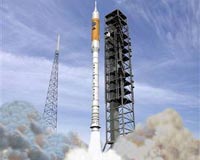 |
Auckland NZ (NZPA) Dec 03, 2009 The battery powering a lost New Zealand rocket's connection to its tracking satellite died about 2pm today, its owner says. A fisherman yesterday found the first stage booster from Atea-1, the first rocket from New Zealand aerospace company Rocket Lab, which was launched from Great Mercury Island off the Coromandel Peninsula on Monday afternoon. But the 2kg payload and the flight computer, both of which could have valuable data about the flight, has yet to be recovered. "It's a 1.8m rocket that's bobbing about in the ocean there and about 300mm to 400mm will be sticking out the top with a silver nose cone," company director Mark Rocket told NZPA. "So I think if anybody's going to be in the vicinity in a boat they will spot it." The search area was over 100sq km and was not practical to mount a grid-style search, Mr Rocket said. "The rest of the rocket is cunningly disguised in black." The company's rocket builders would be changing their recovery systems for their next launch, he said. "The main thing that we were totally focussed on was to get the rocket to reach altitude and the recovery system was something we didn't have as much time to spend on as we would have liked, but we'll certainly be focussing on that for the next version of Atea-1." The team was going to study the sea currents to see where it might wash up. Mr Rocket did not expect the rocket would be particularly dangerous to touch and urged anyone who found it to pop it in their boat. "Obviously you're going to have to be very careful handling it because it is a rocket and you don't want to just chuck it in the back." Share This Article With Planet Earth
Related Links Rocket Lab Rocket Science News at Space-Travel.Com
 NASA Uses Twin Processes To Develop New Tank Dome Technology
NASA Uses Twin Processes To Develop New Tank Dome TechnologyHuntsville AL (SPX) Dec 02, 2009 NASA has partnered with Lockheed Martin Space Systems in Denver, Colo., and MT Aerospace in Augsburg, Germany, to successfully manufacture the first full-scale friction stir welded and spun formed tank dome designed for use in large liquid propellant tanks. The NASA and Lockheed Martin team traveled to Germany to witness the first successful aerospace application of two separate ... read more |
|
| The content herein, unless otherwise known to be public domain, are Copyright 1995-2009 - SpaceDaily. AFP and UPI Wire Stories are copyright Agence France-Presse and United Press International. ESA Portal Reports are copyright European Space Agency. All NASA sourced material is public domain. Additional copyrights may apply in whole or part to other bona fide parties. Advertising does not imply endorsement,agreement or approval of any opinions, statements or information provided by SpaceDaily on any Web page published or hosted by SpaceDaily. Privacy Statement |